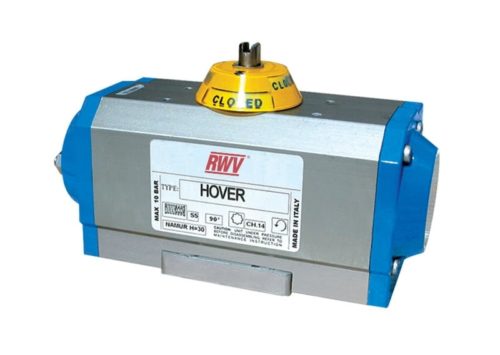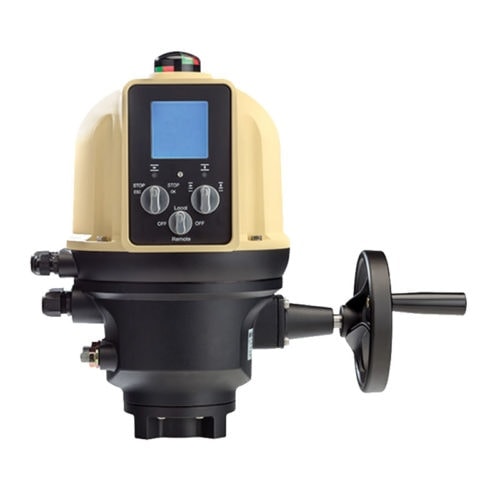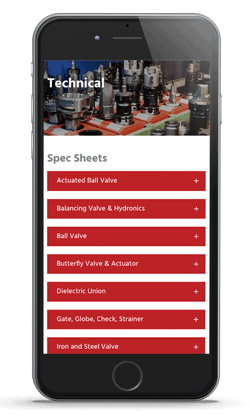At RED-WHITE VALVE CORP., we are a premier supplier of valves and related products for the plumbing, commercial, industrial, and HVAC markets. One of our core product offerings is valve actuators, which are used to facilitate valve operation in fluid handling systems across a wide range of industries and applications. Our experts have put together the following guide on these important devices to help readers understand what they are, what they do, what types are available, and how to select the right one for their needs.
What Are Valve Actuators?
A valve actuator is a mechanical device that moves the valve’s closure element to open and close its flow passages as needed. It can be operated manually by a human worker or automatically by an outside power source (e.g., electricity, compressed air, or compressed hydraulic fluid). Depending on its design, it can be used for on-off flow applications and/or throttling flow applications.
What Do Valve Actuators Do?
Regardless of the method of actuation, all valve actuators must perform a number of basic functions, including the following:
- Move the closure element: The closure element refers to the component (e.g., the ball, disc, or plug) used to partially or completely block the flow of fluid through the valve. The valve’s actuator must be able to provide the force necessary to move and position the closure element as needed, even under demanding process conditions.
- Maintain the closure element position: In addition to moving the closure element, the actuator must be able to keep it in the desired position. It may use a spring, fluid power, or mechanical stiffness for this purpose, depending on its type.
- Seat the valve with sufficient torque: The actuator must generate and maintain enough torque to hold the valve in the closed position during shutoff operations.
- Have a failure mode: In the event of power failure, the actuator should have an appropriate failure mode (e.g., as-is, fully closed, fully open) to ensure the system does not experience excessive damage.
- Provide proper rotational capabilities: Actuators must be able to accommodate the rotational capacities (generally 90 or 180 degrees) of their valves.
- Operate at the appropriate speed: Special control circuit elements can be used to regulate the cycle speed of a valve actuator. For fast cycle speeds that fall below half of the standard actuator cycle time, it is important to carefully select the valve to avoid shock-related damage to its parts.
Types of Valve Actuators / Actuation Methods
Valve actuators come in a variety of designs and configurations, each of which offers unique benefits and limitations that make it suitable for different applications. Understanding the distinctions between the various types is essential to selecting the right one for a particular use case. Below, we highlight three of the most common types of valve actuators.
Manual Valve Actuators
Manual valve actuators use hand-operated levers or wheels that engage a series of gears to open or close the valve. While they tend to be low in cost and simple to use, manual valve actuators are limited to applications in which automated or remote valve control is not required.
The types of manual valve actuators available include:
- Basic levers: Basic lever actuators consist of a long handle that attaches to the valve stem to enable valve rotation.
- Handwheels: Handwheel actuators consist of a large handwheel and gearbox, the latter of which increases the mechanical advantage. They are commonly used in larger valves that need higher amounts of torque to operate.
- Manual valves with limit switches: Manual valves can be equipped with limit switches to convey the position of the valve to the control system.
 Pneumatic Valve Actuators
Pneumatic Valve Actuators
Pneumatic valve actuators provide automatic or semi-automatic valve operation by converting the energy from compressed air into mechanical motion. They work by containing the air within a chamber and allowing it to expand, which creates a difference in pressure between the inside and outside of the chamber. The pressure differential energizes the air. It can then be directed out of the chamber toward the mechanical component used to open and close the valve.
The types of pneumatic valve actuators available include:
- Rotary pneumatic valve actuators: Rotary pneumatic valve actuators convert the energy from compressed air into rotational motion to operate rotary valves (e.g., ball, butterfly, and plug valves). They can be classified into two main categories—rack & pinion actuators and Scotch yoke actuators.
- Linear pneumatic valve actuators: Linear pneumatic valve actuators convert the energy from compressed air into linear motion to operate linear valves (e.g., gate and globe valves). They can be classified into two main categories—diaphragm actuators and cylinder actuators.
 Electric Valve Actuators
Electric Valve Actuators
Electric valve actuators use an alternating current (AC) or direct current (DC) motor to generate the torque required for valve operation. The motor is attached to the valve stem through a series of gears and controlled by a cam-activated limit switch. Together, these components allow for accurate and precise adjustment of the valve.
The types of electric valve actuators available include:
- Rotary electric valve actuators: Rotary electric valve actuators convert electric energy into rotary motion for the operation of rotary valves.
- Linear electric valve actuators: Linear electric valve actuators convert electric energy into linear motion for the operation of linear valves.
How to Select the Right Valve Actuator
Given the broad selection of valve actuators available, it is important to carefully research your options, so you select the one that is best for your needs. Some factors to keep in mind when evaluating whether a particular product is right for your application include:
- Power source availability: Does your facility have the necessary power source to operate the actuator? If you choose to use a powered valve actuator, your facility must be equipped with the appropriate power source. For example, electric actuators need an electric motor, while pneumatic actuators need a compressed air supply.
- Automation requirements: Do you want to automate valve functions? Automation allows you to monitor and control valves without having to be physically near them. While manual actuators do not accommodate automation, powered actuators do.
- Application conditions: What conditions will the actuator face within the application? Regarding temperature, pneumatic actuators are suitable for use in temperatures ranging from -4–150° F, while electric actuators can operate in temperatures ranging from -40–150° F. Regarding hazardous environments, pneumatic actuators are the preferred choice since they are explosion-proof. However, electric actuators can be used if they have an appropriate NEMA-rated enclosure.
- Emissions: Are you trying to minimize your facility’s emissions? Pneumatic actuators emit various levels of methane gas into the atmosphere as they operate, creating a challenge for highly regulated industries that must keep their emissions low. Electric actuators provide a zero-emissions alternative to pneumatic designs, allowing companies to comply with increasingly strict environmental regulations.
- Cost: How much are you willing to pay for your actuator? Both manual and pneumatic actuators have lower upfront costs compared with electric designs. However, the higher efficiency and reduced emissions of electric actuators can provide significant long-term cost benefits in the right applications.
Quality Valve Actuators From RED-WHITE VALVE CORP.
Valve actuators play a vital role in fluid handling systems. That’s why it is important to source them from a reliable supplier. For valve actuators you can trust in your most critical applications, turn to the experts at RED-WHITE VALVE CORP. As valve technology leaders, we have the knowledge and skills to design and manufacture valve products, including actuators, that meet some of the strictest performance and quality standards. To learn more about our valve actuators, contact us today.


